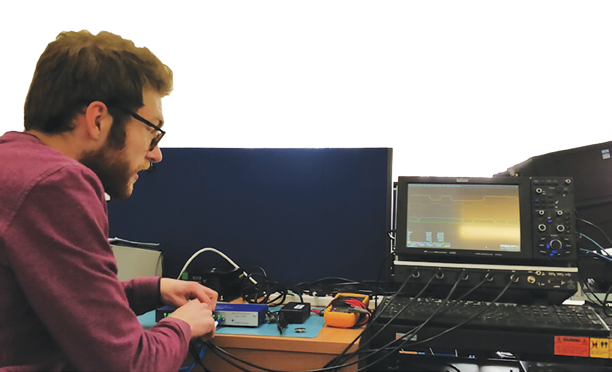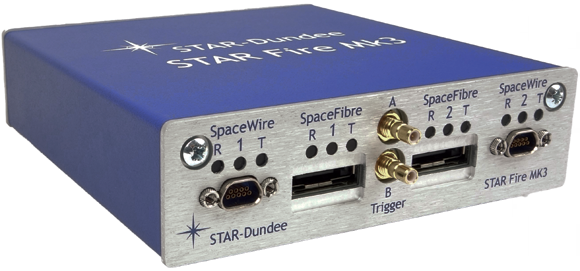STAR-Dundee was formed in 2002 to commercialize research performed by the University of Dundee while writing the SpaceWire standard on behalf of the European Space Agency (ESA), and the company has continued to innovate and to contribute to new standards.
SpaceWire was designed specifically for use onboard spacecraft. One of the main advantages of SpaceWire is its low complexity (hence, low gate count) and the fact that it can be implemented easily in ASICs and FPGAs.

SpaceWire is a packet switching network that uses worm-hole routing switches for routing packets across the network. Worm-hole routing was adopted because it minimizes the amount of buffer memory needed in the routing switches, an important consideration for implementation in radiation tolerant chips where memory is at a premium.
Providing high-speed (2 to 200 Mbit/s), bi-directional, full-duplex, data links, these connect together SpaceWire-enabled equipment.
_________________________________
SpaceFibre offers much more than
high data rates — the technology is
capable of detecting, isolating and
recovering from faults in the link where
they occur and that prevents faults from
propagating and causing further errors.
_________________________________
It is able to support many different payload processing architectures using point-to-point links and SpaceWire routing switches. The data-handling architecture can be constructed to suit the requirements of a specific mission, rather than having to force the application onto a bus or network with restricted topology.
The SpaceWire standard was published by ESA’s standardization body, the European Cooperation for Space Standardization (ECSS), in 2003 and was quickly adopted internationally by the likes of ESA, JAXA, NASA and Roscosmos and is now being widely used on scientific, Earth Observation (EO), commercial and other spacecraft.
High profile missions using SpaceWire include BepiColombo, Gaia, GOES-R, James Webb Space Telescope, Hitomi, Lunar Reconnaissance Orbiter and the Rosalind Franklin rover.
STAR-Dundee has grown with SpaceWire — the company now features a strong team of knowledgeable and experienced engineers who provide high quality products and support. Included within this expansion has been the establishment of a wholly-owned subsidiary in Barcelona, imaginatively titled STAR-Barcelona.
STAR-Dundee’s product range has grown to now offer a comprehensive range of SpaceWire test and development products and IP cores that have been used on many of the missions flying SpaceWire.
These test and development products include interface devices, routing devices, link analyzers, recorders, conformance and protocol testers, device emulators and flight chip development kits.
The company’s IP cores are widely used across the space industry, including in the SpaceWire 10X Router ASIC (AT7910E) and SpaceWire Remote Terminal Controller ASIC (AT7913E) radiation tolerant chips.

SpaceFibre — The Next Generation of SpaceWire Technology
STAR-Dundee continues to innovate and develop new technologies. For the past decade, STAR-Dundee has been leading the development of the next generation of SpaceWire technology: SpaceFibre. These efforts were recently rewarded with the publication of the SpaceFibre standard, “ECSS-E-ST-50-11C – SpaceFibre – Very high-speed serial link”, by the ECSS.
SpaceFibre provides data signaling rates of 6.25 Gbit/s in current flight technology, over electrical or fiber optic cables, while its unique multi-laning features allow up to 16 lanes to be combined into a single link, giving a theoretical link rate of 100 Gbit/s.
SpaceFibre offers much more than high data rates — the technology is capable of detecting, isolating and recovering from faults in the link where they occur and that prevents faults from propagating and causing further errors.
SpaceFibre provides galvanic isolation, transparent recovery from transient errors, error containment in virtual channels and frames, and “Babbling Node” protection. Very versatile quality of service mechanisms allow scheduled, deterministic communication without wasting any network bandwidth.
These powerful capabilities mean that SpaceFibre is suitable for very high data rate payloads, such as Synthetic Aperture Radar (SAR) and multi-spectral imaging instruments as well as be used for network and equipment management and for deterministic command and control type applications.
SpaceFibre allows each of these traffic types with different requirements to share a single network, with each traffic stream operating independently within its own virtual network.
SpaceFibre has been, and is being designed into, its first ASICs, on-board equipment and space missions. The powerful Ramon Chips RC64 many-core DSP features STAR-Dundee IP to provide 12 SpaceFibre ports each offering up to 6.25 Gbit/s data signaling rate.
SpaceFibre is being used in Europe, USA, Russia and Japan and has been incorporated in the latest revision of the ANSI/VITA 78 SpaceVPX backplane standard.
As with the SpaceWire standard, Steve Parkes, CTO of STAR-Dundee and formerly the Chair of Spacecraft Electronic Systems at the University of Dundee, wrote the SpaceFibre standard with inputs from international spacecraft engineers. STAR-Dundee has designed, implemented and tested:
• The first SpaceFibre interface
• The first SpaceFibre routing switch
• The first SpaceFibre multi-lane interface
• The first SpaceWire to SpaceFibre interface device
• The first experimental SpaceFibre interface ASIC (VHiSSI)
• The first SpaceFibre interfaces in a many core processor (Ramon Chips’ RC64)
• The first SpaceFibre interface in a radiation tolerant FPGA (Microchip’s RTG4)
• The first SpaceFibre routing switch in a radiation tolerant FPGA
• The first SpaceFibre multi-lane interface in a radiation tolerant FPGA
• The first SpaceFibre link analyser
• The first SpaceFibre interface board.
In addition, STAR-Dundee has demonstrated the first complete SpaceFibre network representative of spaceflight applications and incorporating radiation tolerant technology.
STAR-Dundee owns a patent on the SpaceFibre multi-lane technology, which is being freely licensed for space related applications.
 STAR-Dundee’s STAR Fire Mk3 SpaceFibre Interface, Link Analyser and SpaceWire Bridge.
STAR-Dundee’s STAR Fire Mk3 SpaceFibre Interface, Link Analyser and SpaceWire Bridge.
STAR-Dundee’s SpaceFibre product range continues to grow. The recently released STAR Fire Mk3 test and development product can transmit and receive both SpaceWire and SpaceFibre traffic; it can interconnect SpaceWire equipment to a SpaceFibre network and it can operate as a SpaceFibre link analyser, capable of unobtrusively capturing and displaying SpaceFibre traffic.
Leveraging these capabilities, it is possible to emulate, stimulate, debug and validate SpaceFibre enabled equipment using the STAR Fire Mk3.
SpaceFibre IP cores available from STAR-Dundee now include a SpaceFibre Single Lane Interface, a SpaceFibre Multi-Lane Interface, a SpaceFibre Router and a SpaceFibre-to-SpaceWire Bridge.
The company is supporting several organizations as they include these IP cores in new missions requiring far higher data rates than were possible with SpaceWire, or which require the deterministic command and control capabilities offered by SpaceFibre’s innovative quality of service mechanisms.
www.star-dundee.com/
Information regarding the SpaceWire standard is available at this direct link...
www.star-dundee.com/knowledge-base/overview-spacewire-standard
Additional information regarding SpaceFibre is available at this direct link...
www.star-dundee.com/knowledge-base/what-is-spacefibre
Stuart Mills is the CEO of STAR-Dundee and one of the company’s founders. He has a First Class Honors Degree in Computer Science and a Ph.D. in Spacecraft Systems, both from the University of Dundee.

